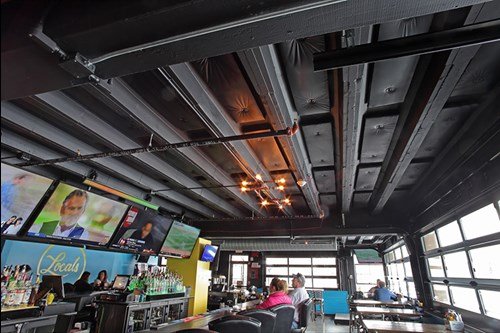The Restaurant Scene is Booming and Many Eateries Need Acoustical Ceilings!
Installing an acoustical ceiling solution keeps patrons around longer, studies show.
THE PUBLIC IS EXCITED TO BE GOING OUT TO EAT AGAIN!
But if a restaurant is booming with an overly loud atmosphere, folks aren’t going to stick around for long. Noise is the second most common complaint among restaurant-goers, according to Zagat.
One study presented at the Acoustical Society of America’s (ASA) 2018 Acoustics Week indicated that patrons’ willingness to spend time and money at a restaurant decreased as the background noise level increased.
If diners have to alter their speech in a noisy restaurant, they are experiencing The Lombard effect, an acoustic phenomenon triggered by background noise created by other patrons’ conversations. The Lombard effect is when speakers unconsciously increase the loudness level of their speech in the presence of background noise in order to be understood. This increased vocal effort and can cause vocal fatigue over time. [source]
SOCIAL BUZZ VS. PLEASANT AMBIANCE
People are ready to get social again, but noise matters. They are seeking the right balance between a lively social atmosphere and letting people hear each other speak.
The atmosphere in restaurants is hugely important to the quality of experience for all occupants. The noise level affects patrons, employees, and owners, all for different reasons. Patrons are simply looking to carry on comfortable conversations, while employees must mitigate the risk of long-term hearing damage from long shifts in a noisy restaurant.
Restaurant owners are looking to attract patrons willing to spend time and money in this space, so the experience has to feel (and sound) just right.
Designers must pay attention to acoustic solutions, which can be challenging. All restaurants are unique, and the acoustic considerations should match other aspects of the space. Noise tolerance at your local burger joint is different from what you want from your favorite intimate dining spot.
Today’s restaurants have open kitchens and bars, so “back of the house” busyness can compound the noise to the dining space. Higher ceilings, fewer tablecloths and rugs, and more windows all contribute to what is essentially a hard-surfaced echo chamber.
ACOUSTIC TREATMENTS FOR RESTAURANTS
“Ceilings designed with proper acoustics are the key to success,” says MBI’s Vice President of Sales, Charles Splain. MBI products such as Masquerade DESCOR® system, Spectrum Acoustical Panels, Cloud-Lite® Acoustical Baffles, or Blackout Faced Acoustic Ceiling Tiles are all ceiling-mounted treatments made with sound-absorbing material that can acoustically correct a restaurant space.
Pick's Sports Bar, a newly renovated space (above left), was completely unusable from a noise standpoint due to its open-concept ceiling. MBI applied Spectrum Panels to the ceiling deck, and it became a more ambient space. The TVs, music, and tableside conversation were all comfortably audible after the acoustic ceiling was installed. What a difference!
Table 530 (above right) has vast windows overlooking a lake, creating an undesirable acoustical environment. Any style of dining room can be complemented with a white Masquerade ceiling treatment, as seen here.
ACOUSTICAL ART, ANYONE?
“Acoustical wall treatments can make all the difference in the world. But between a restaurant’s artwork, windows, exposed brick or stone, and TVs, there is typically very little wall space that can be treated,” Splain continues. MBI’s Colorsonix® acoustic art panels are a good choice for wall treatments.
The Pour House at Machinery Hall has mounted Colorsonix art wall panels to enhance both the sound atmosphere and the restaurant branding
Masquerade acoustical wall panels are also a great choice, as they can be printed with any art imaginable and still maintain their sound-absorbing properties. “Sometimes, we see restaurant owners choosing these panels to replace existing art because they are lower cost and dual-purpose,” Splain says.
GETTING YOUR MONEY’S WORTH
“Restaurants are tricky spaces. There is no standard formula for sound absorption because each location is unique,” says Splain. “For new and renovated spaces, an acoustical engineer should absolutely be part of the project. It requires an investment, but the return will bear out in patrons willing to stay and spend.”
If your business requires service to customers in a large space, make certain that the acoustics are optimal. Patrons are more likely to stay longer in a restaurant, brewery, or bar that is acoustically pleasant.
READ MBI’S SIBLING REVELRY BREWERY CASE STUDY






